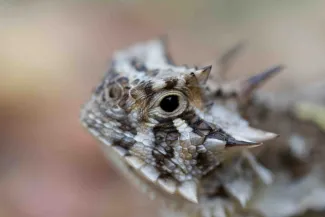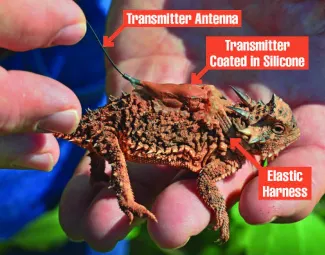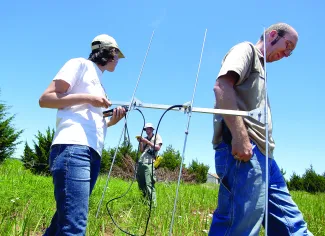Mention of Tinker Air Force Base, the world’s largest military maintenance depot situated just outside of Oklahoma City, conjures images of airplanes, runways and airmen for most people. But Tinker isn’t just a major military hub filled with flight-related sights. It’s also an urban retreat for many species of wildlife, including the Texas horned lizard.

This formidable-looking lizard, 4 inches long with a row of horns protruding from the back of the head and spines covering most of the body, has found a refuge in Tinker’s undeveloped natural reserves.
While planes thunder down nearby runways and servicemen conduct training, a small squadron of lizards is searching for ants, seemingly indifferent to the daily din of commotion.
Tinker’s city-dwelling horned lizards have offered an exciting look into how this declining species adjusts to an urban environment. By tracking lizard’s movements and learning more about their life needs, biologists may be able to develop a strategy for managing this species of greatest conservation need in a progressively urbanized landscape.
To do this, research efforts have been focused on one of the base’s three natural reserves closest to a housing development project. There biologists have captured hundreds of adult lizards over the years.
Once captured, a small transmitter that emits a unique radio frequency is attached to each lizard’s back with silicon adhesive and an elastic collar. These “backpacks” weigh less than a penny; anything heavier would affect the lizard’s movement and chances of survival.

Biologists use radio transmitter "backpacks" to track the movements of the Texas horned lizards at Tinker Air Force Base.
After attaching the transmitter, biologists release the lizard and later track it using a receiver and antenna that can tune to a specific transmitter’s frequency. The closer the receiver is to the dialed-in transmitter, the louder the receiver’s beep. By following increasingly intense beeps, researchers can narrow their search radius within the 22-acre study area to less than a square yard. Once inside that square yard, visual searches are conducted until the lizard is found. The lizard’s precise location is then recorded on a GPS unit along with information about the nearby habitat and the lizard’s condition.
Despite this technological edge, Texas horned lizards can be a challenge to find. Their tan bodies blend well with the surrounding soil. Unless the lizard moves and catches the eye of the researcher, it can easily disappear in to the prairie. To further complicate matters, lizards often burrow into the leaf litter or loose soil during summer to escape the heat of the day and potential predators.
When this happens, researchers change their search image from a camouflaged smartphone-sized lizard to a thin, black transmitter antenna. Locating burrowed lizards is as difficult as it sounds. Shadows, blades of grass and fallen leaves can easily hide the antenna, which also looks like a twig or blade of grass. In spite of this challenge, researchers are persistent and continue the search until the lizard’s exact location is recorded.
Even after 13 years of tracking Texas horned lizards, the research team still finds lizards in unexpected places.
“We’ve found lizards in trees before. They’ll go less than a foot up and perch on the low branches,” said Ray Moody, natural resource biologist for Tinker AFB. Another time, the team tracked an uncommonly fast-moving transmitter to a blackberry thicket. Instead of finding a Texas horned lizard, they found a copperhead with a transmitter-shaped bulge. The snake had eaten the research lizard, transmitter and all! The copperhead was safely captured held in the lab until the transmitter was excreted, then deployed again back on site.
Though radio transmitters have played a crucial role in Texas horned lizard research at Tinker Air Force Base, they can only help answer questions about the movement of adult lizards. The transmitters, the most cost-effective way to track adults, are too large to place on hatchling lizards.
But out-of-the-box thinking has allowed the researchers to jump this particular hurdle.
Instead of attaching a transmitter to the quarter-size hatchlings, researchers are using technology designed to help search-and-rescue teams find victims of avalanches. The same microwave signal-producing copper diode that is sewn into ski jackets is superglued to the hatchling’s back. Because these diodes reflect signals on the same frequency and researchers aren’t able to distinguish individual hatchlings, they color-code the newly hatched lizards with drops of hobby or craft paint.
Similar to adults, the hatchlings are tracked to their current location by listening for the signal with an antenna and receiver. After the hatchlings are found and recaptured, they are identified by their individual paint pattern. When the hatchlings are large enough, the diodes are replaced with radio transmitters that allow the research team to track specific lizards from greater distances.
Long-term research projects such as this one require a dedicated staff. Researchers spend more than 1,400 hours each year searching for the research lizards at Tinker. To help with this time commitment, the Oklahoma City Zoo volunteers to track the lizards.

Researchers use a telemetry antenna to track radio signals from Texas horned lizards at Tinker Air Force Base. (Margo Wright)
“The OKC Zoo supplies additional leg power for this project. Zoo volunteers are here weekly from April to October to monitor the lizards,” Moody said. But the long hours spent searching for a 4-inch lizard in the middle of a grassland are worth the effort.
Biologists at Tinker now know that Texas horned lizards spend most of their time in a 2-acre area. These home ranges often overlap. Research has found that hatchling survival is extremely important to the population.
Though Moody and other biologists are concerned with the range-wide population decline of Texas horned lizards, he remains positive. “I’m seeing a lot of recruitment – a lot of baby lizards – and that’s a good sign.”
The unique opportunity to study an urban population of Texas horned lizards has drawn a great deal of interest. Researchers from at least four universities have visited the area to test their theories – and not just theories on how lizards move across the landscape.
Related studies conducted at Tinker AFB have helped develop habitat models and answer questions about gene flow within lizard populations. Moody is excited to have so many researchers and universities involved in the project. “When their results are published, it helps Texas horned lizard management across the entire range.”